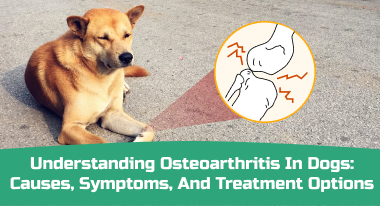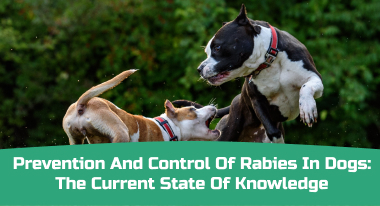Table of Contents
Like humans, dogs can have cognitive impairment (sometimes known as “doggy dementia”) as they age. Over time, it creates behavior changes that tend to get worse. Despite the fact that there is no treatment for cognitive dysfunction, there are things you can do to support your pet and ensure that they continue to have a healthy life.
If you suspect your dog has cognitive dysfunction, speak with your veterinarian as soon as possible. The sooner the dog receives therapy, the better the prognosis.
What Precisely is Cognitive Dysfunction Syndrome?
Alzheimer’s disease in dogs is called cognitive dysfunction syndrome (CDS). With CDS, a dog’s brain gradually deteriorates, resulting in aberrant and senile behaviors that reveal worsening cognitive function. Older dogs are more likely to get CDS, starting around nine.
Age-related brain changes are the root cause of CDS. Beta-amyloid protein, a toxin to the brain, builds up in dogs with CDS. Reduced blood flow and malfunctioning neurons are two more abnormalities in the brain. The cells transmitting information throughout the body and brain are neurons. The brain’s capacity to recall, process information, and direct the body is compromised when neurons don’t work correctly.
Cognitive Dysfunction in Dogs: Symptoms
The most prevalent signs of dementia in dogs include:
Disorientation/confusion
- Getting hung up on obstacles
- Difficulty recognizing well-known persons or pets
- Blankly observing the walls
- Pacing
Behavior changes
- Absolute irritability
- Lower desire to play
- Overly licking
- Lack of personal grooming
- Appetite loss (anorexia)
Anxiety, Agitation, and Memory Impairment
- The apparent disregard for previously learned instruction or home rules
- Unable to quickly pick up new skills
- Unable to follow well-traveled paths
- Fecal and urine soiling in the home
Sleep cycle changes
- Waking up in the middle of the night
- Vocalizations at night
- Evening pacing
Since every dog is unique, the development of its symptoms may vary. Usually, the initial signs and symptoms are less severe and worsen as the condition worsens. Owners should see a veterinarian with their concerns if they believe their dog is displaying any of these signs.
Using an infographic, let’s condense the canine cognitive dysfunction syndrome symptoms into one concise statement:
Cognitive Dysfunction in Dogs: Symptoms
What is cognitive dysfunction and what symptoms should you be looking out for in your pets? Here are some pointers-
#1. Interactions
Possible encounters include strange behaviors with familiar individuals or animals. Aggression, irritation, or a shift in the frequency of social engagement may be seen.
#2. Disoriented
Gets “stuck” in corners of the home, forgets how to navigate around furniture, and overlooks the water or food dish’s location. It also involves gazing aimlessly at the floor or walls, becoming wedged behind objects, entering from the wrong side of the door, etc.
#3. Home soiling
Possible behaviors include urinating or defecating in previously kept-clean areas and showing the owner less indication when they need to go outside. Eliminating inside right away after returning from the outside.
#4. Shift in the sleep-wake cycle
Unable to get comfortable and sleep at night. Spend the night wandering around.
#5. Changes in behavior
May become more aggressive, and stop eating or drinking when they’re thirsty. Seem confused and disoriented, making them hard to handle. Loss of interest in you or your family, an increased tendency to sleep, a lack of desire to play, or a drop in activity levels.
#6. Changes in memory
They have trouble remembering things around them, including family members and their names. Often become depressed or anxious, making them harder to handle and increasing the risk of aggression if left unchecked.

Why Do Dogs Get Cognitive Dysfunction?
Although the precise origins of CCD are unknown, many of the same changes that lead to issues in older people are likely to impact our dogs as well. Researchers are examining how CCD and Alzheimer’s disease are similar. Here are some things we do know about the aging of our canine pets, although research is ongoing and new information is continually emerging.
The brain of older dogs atrophies or dies due to cell death. The cerebral cortex, which houses the brain’s learning and memory centers and the areas in charge of coordination, are particularly impacted by this (the cerebellum).
According to research, dogs with CCD have abnormal protein buildup in their brains called beta-amyloid. There is less nerve signaling in the brain due to this protein accumulation. High concentrations of a substance called monoamine oxidase B to break down neurotransmitters, which aid the brain in sending messages, in dogs with CCD (MAOB).
It has also been demonstrated that dogs who are sedentary and dogs with epilepsy are more likely to develop CCD.
How To Treat Canine Cognitive Dysfunction
The CDS in dogs is incurable. However, there are various treatments that might stop the disease’s progression and lessen some of the symptoms the dog experiences.
CDS treatments consist of:
Dietary modifications
Your dog might be put on a therapeutic diet specifically created to help. These diets include nutrients, including fatty acids, lipids, and antioxidants that may support and protect healthy brain cells.
Dietary supplements
Your veterinarian may suggest dietary supplements like Senilife®, which is high in antioxidants, or oils rich in “medium-chain triglycerides,” a form of fat that provides energy to the dog’s brain because the brain is less able to utilize glucose for energy in CDS.
Medication
Your veterinarian may suggest drugs that could enhance your dog’s cognitive function. These include MAO inhibitors like Anipryl, which could facilitate neuronal communication and shield the brain from harm. Medicines that improve blood flow to the brain, including propentofylline, approved for usage in some European nations, may benefit dogs with CDS.
Cognitive enrichment
Enriching your dog’s mind may help it think more clearly. Exercise, social connections, giving your dog new toys, and teaching them further instructions are all examples of cognitive enrichment.
Some vets might advise attempting acupuncture and herbal treatments. Although they have not been thoroughly researched in CDS-affected dogs, these techniques may benefit affected dogs.
Other Therapies for Dog Dementia
The quality of life can be significantly improved by receiving hands-on bodywork. It can enhance connection while relieving pain and anxiety. For dogs with dementia, acupuncture or acupressure combined with traditional Chinese herbs can be helpful.
There is also a tonne of commercial treatments available for dogs with dementia. I advise looking for a holistic veterinarian or a knowledgeable animal naturopath. They can ensure that you provide your old companion with the most outstanding care possible.
Finally, but certainly not least, enrichment, a little exercise, and love. Play basic games, have moderate training sessions, give your aging dog intentional touches, and take him for regular light exercise. This will help to stimulate his mind.
Canine Cognitive Dysfunction: How is it Prevented?
It’s crucial to make the change into the disease’s course smooth and stress-free so that dogs may manage CCD with the least amount of distress possible. Predominant in the dog’s coping mechanism is the environment in which it lives. To keep the environment familiar to the dog, think about clearing the house of clutter to remove potential impediments, keeping commands simple to reduce confusion, including the dog, in brief, friendly play sessions, and creating a feeding and watering plan that adheres to a regular. To ensure clarity and mobility issues, avoid redecorating or rearranging the furniture in the home.
It may be possible to prevent Cognitive Dysfunction in your pet and improve overall health by keeping them cognitively and physically engaged and at a healthy weight. Toys that require your pet to think to receive treats or food are an excellent way to keep their minds active. Additionally, it’s crucial to practice preventative health by consulting your veterinarian as soon as any behavioral or medical changes are seen.
Comparison Table
The percentage of dogs at various ages who have at least one CCD-related impairment is shown in the following table.
| AGE OF DOG | % AFFECTED |
| 11-12 years | 28% |
| 14 years | 48% |
| 16 years | 68% |
Vet Examinations for Dogs with Dementia
Periodically, your dog will be examined by your veterinarian to track the symptoms’ development and how well they respond to treatment.
However, you should contact your veterinarian immediately if you observe any behavioral changes in your dog.
Any alteration in elderly dogs might be severe; therefore, it’s crucial to consult your veterinarian immediately. Unless new issues occur, twice-yearly examinations for stable people might be sufficient.
The Average Lifespan of Dogs with Dementia
Life expectancy can be difficult because canine cognitive impairment is a degenerative disease that manifests in a dog’s senior years, comparable to Alzheimer’s in humans. There is no defined timeline for when dementia will start to affect your dog’s quality of life if they are generally healthy.
Working with your veterinarian and keeping tabs on your dog’s quality of life are the most incredible ways to keep track of your dog’s health and cognitive abilities. This will enable you to understand when your dog is signaling it is time.
To Summarize
In older dogs, cognitive impairment is a common problem. Disorientation, interactions, sleep changes, house soiling, and activity changes (referred to as DISHA) are the clinical symptoms of cognitive impairment.
When these symptoms are identified, a treatment plan can be started by combining behavioral treatments, drugs, dietary modifications, and nutritional supplements.
Disclaimer: The content on the site is for educational purposes only, and it does not provide medical advice. The shared information must not be treated as a substitute for or alternative for medical practitioner advice, diagnosis, or treatment. Regarding any concerns about your pet’s health, seeking veterinary guidance is of utmost necessity. Each pet has specific health, fitness & nutrition needs. Do not disregard, avoid or delay pet health-related advice from veterinarians based on reading the information provided on this site.
FAQ’s
1. Is Cognitive Dysfunction in Dogs fatal?
Answer: Dementia rarely results in death on its own, but the combination of cognitive impairment and physical health issues is highly crippling.
When administered early in cognitive impairment, canine dementia treatments are most successful.
2. What are the Canine Dysfunction Cognitive Stages?
Answer: Dogs have three stages of dementia: mild, moderate, and severe. Within each level, there are recurring patterns. It’s crucial to remember that not all dogs go through these precise stages or patterns.
3. Does Canine Cognitive Dysfunction respond to CBD oil?
Answer: Products with CBD are excellent for boosting mental acuity and are recommended as a canine cognitive dysfunction prevention strategy. The protection of the brain by CBD has been demonstrated. Although CBD cannot treat dementia, it can help pets cope with the stress and anxiety that the disease may cause.
4. How long can a dog live with canine cognitive dysfunction?
Answer: Dog CDS has no known treatment; thus, it will continue to worsen. The dog might live an entire, fulfilling life if CDS is identified early and adequately treated. Sadly, dogs with severe CDS typically experience worse outcomes and are frequently put to sleep around 2 years after the first CDS symptoms occur.



